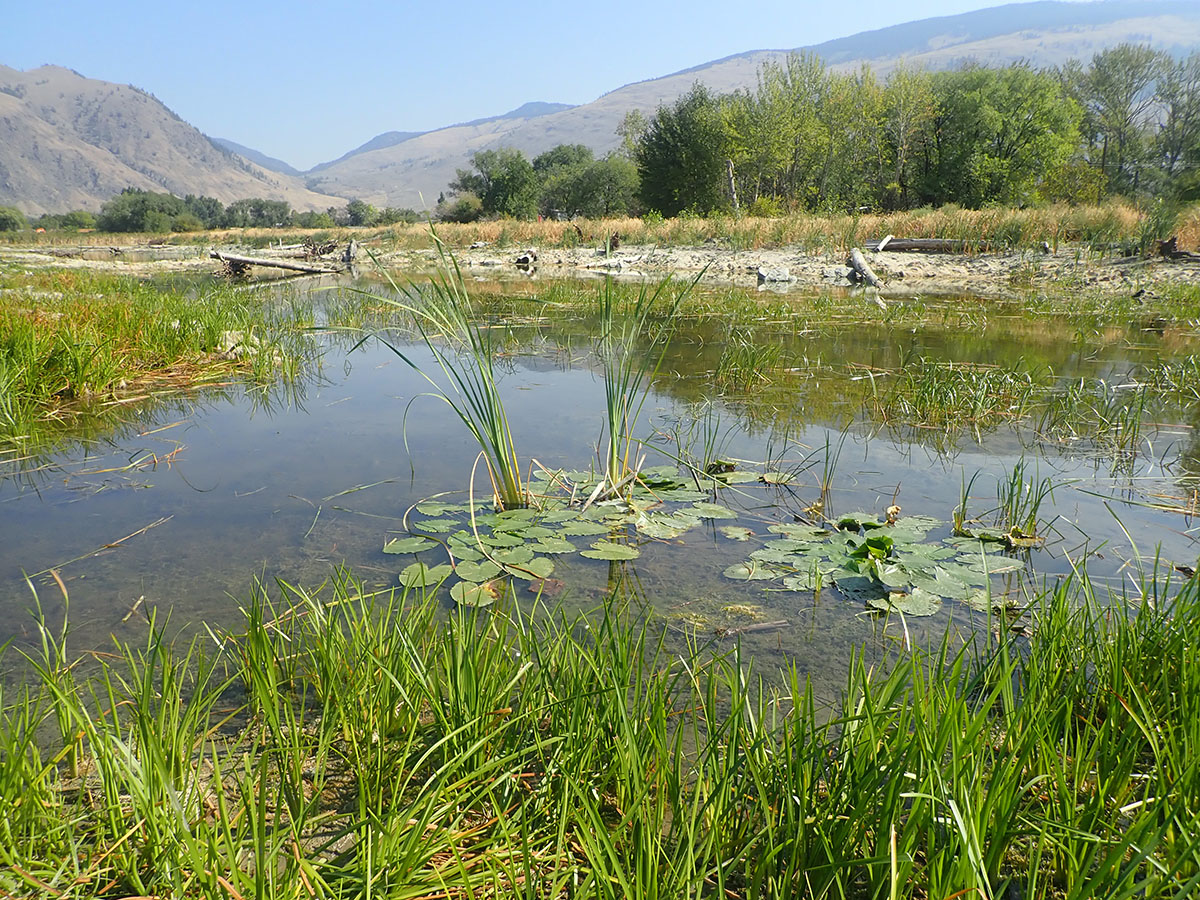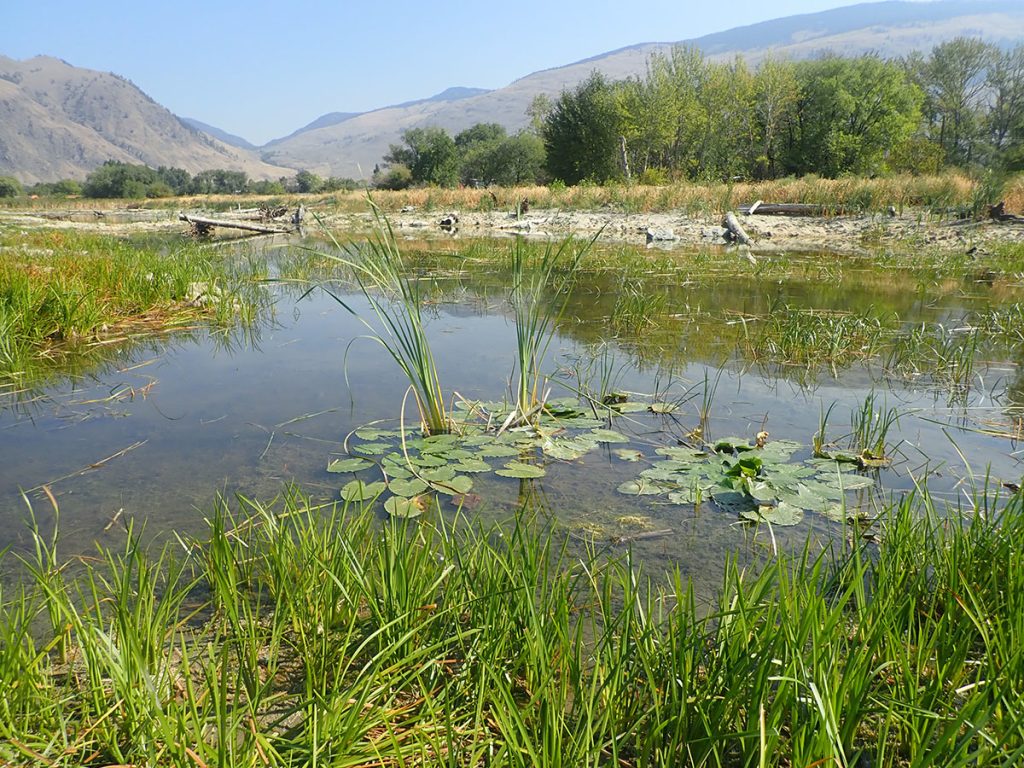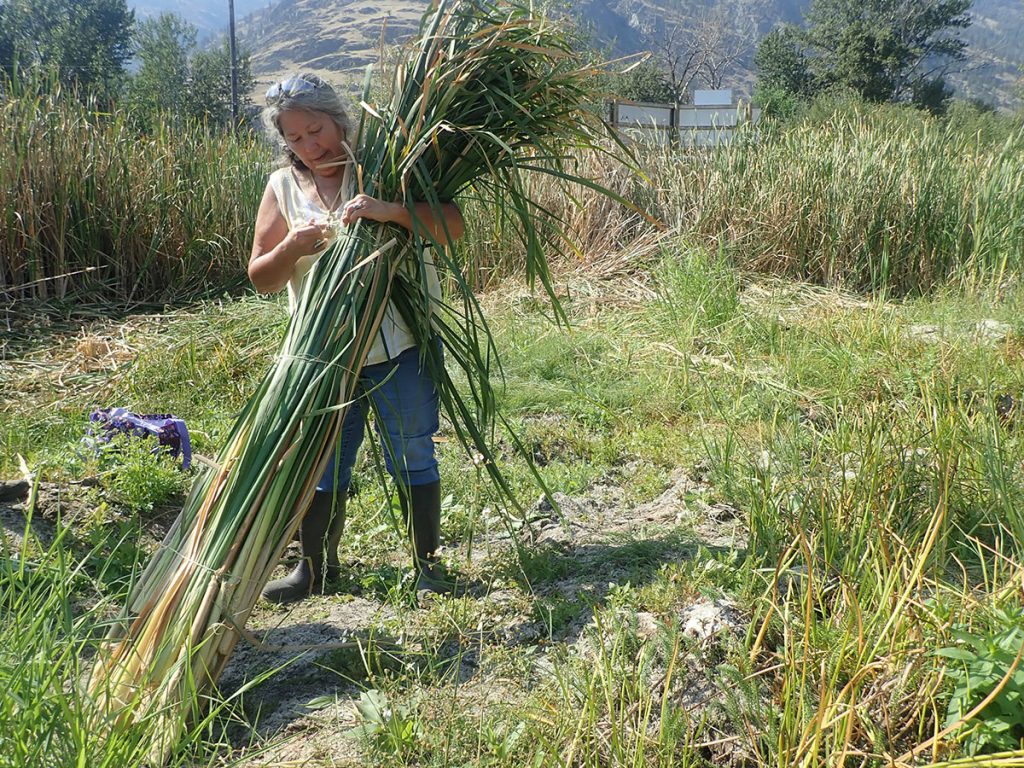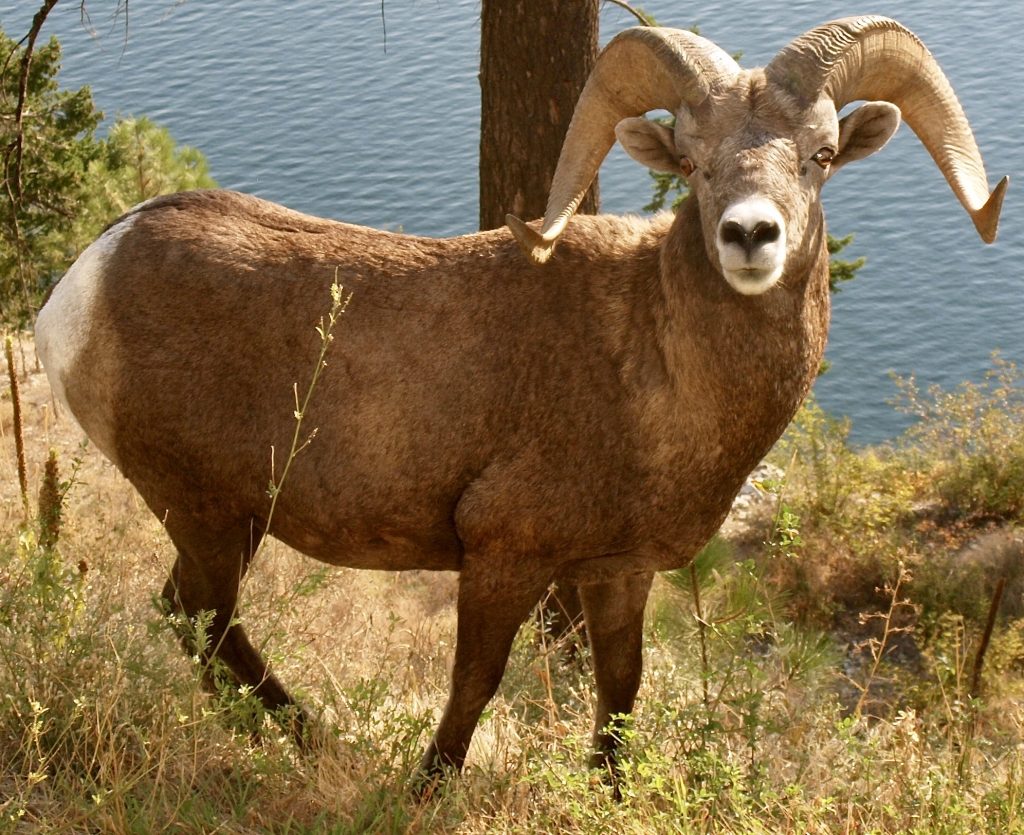SILT NEWS
Home > News

nʔaʕx̌ʷt – Ginty’s Pond Wetland Restoration
Restoration of the nʔaʕx̌ʷt – Ginty’s Pond wetland at Cawston exceeds targets!
Abundant wildlife, cultural use, and nature-related recreation have returned to SILT’s nʔaʕx̌ʷt – Ginty’s Pond wetland at Cawston in the Similkameen River watershed. Two of a planned three phases of restoration to return the aging wetland to more productive open-water habitat, and to create new species-at-risk habitats, are complete.
Planning and fund-raising for a final Phase 3 recovery effort next year are underway. Stewardship activities in 2025 included monitoring of wildlife use and planted trees and shrubs, planting more ‘emergent’ aquatic plants—those that grow along the water’s edge, cattail mowing to prevent future encroachment, and building and maintain relationships with pond neighbours and community volunteers.
Securing the confidence and support of donors, grantors, project partners, and neighbours is key to sustaining SILT and nʔaʕx̌ʷt – Ginty’s Pond forever. Project partners include the Lower Similkameen Indian Band, the BC Wildlife Federation, and the BC Ministry of Water, Land, and Resource Stewardship. Key funding for Phases 1 and 2 included the Healthy Watersheds Initiative, BC’s Together for Wildlife Fund, Canada’s Natural Heritage Conservation Program, the Habitat Conservation Trust Foundation, Nature Trust of BC, and Wildlife Habitat Canada.
Without further financial support, the final Phase 3 restoration is at risk! Please help us reach our goal of raising the $168,000 project cost. To contribute, contact apeatt@siltrust.ca or visit www.siltrust.ca/donate. You’ll be making a lasting contribution to nature, community, and the long-term health of the Similkameen River watershed.
And, if you own property near Cawston, you can help further by encouraging Area B of the regional district to participate in the South Okanagan Conservation Fund, which helps support ecological services like wetlands and wildlife, that benefit your local community.







Vehicles & Dumping are Damaging Habitat
Despite a vehicle closure now in its 5th year, people continue to disregard SILT’s private land ownership of its Grand Forks Grasslands conservation property.
People are welcome to walk on SILT’s land to enjoy nature and wildlife-related recreation, but vehicles, dogs, fires, litter, livestock, and camping are all prohibited. “SILT purchased this land to protect and produce wildlife”, says SILT’s executive director and biologist, Al Peatt. “We will be ramping up controls to prevent further habitat damage by trespassers.”
Users are asked to obey signage and respect this sensitive grassland. The Morrissey Creek public road ends before the yellow gate, and all vehicle operators are asked to park there or turn around. The land beyond the yellow gate is private; there are no public trails or roads beyond the gate.

Supporting Land Conservation
There are many ways you can support land conservation
Land trusts always seem to be in fund-raising mode to purchase properties that have special features essential to wildlife, but acquiring the property is only the first step.
Once a property is acquired, it needs to be managed and sometimes restored to maintain the ecological values for which it was protected. That includes putting up fences to keep cattle out, installing signs and gates to guide public use, or replanting native species to support wildlife. These kinds of maintenance and restoration efforts all come at a cost.
The Southern Interior Land Trust (SILT) was formed in 1988 to purchase land for wildlife in the southern interior of BC. SILT is run by a volunteer board of directors and a part-time contracted executive-director, operating with minimal resources. SILT stewards seven conservation properties without any regular government funding and no endowment to support its daily operations.
Ironically, SILT’s responsibility to steward its lands sometimes extends to defending their natural features from the public—which, after all, is the ultimate beneficiary of the land conserved. Beyond management, SILT also takes its responsibility seriously to defend the sanctity of natural features essential to wildlife on the lands we conserve, notes President Judie Steeves.
Conservation lands are often secured with public donations and SILT has a responsibility to protect the habitat values for which the lands were acquired, including large standing dead or dying trees, known as wildlife trees, and other valuable features such as wet areas and winter range, bunchgrass meadows, fresh water, wetlands, craggy outcroppings, and tree cover, or south-facing slopes that green up early in spring.
“The public is welcome to enjoy nature on our conservation lands with common-sense restrictions such as no motorized vehicle use, which causes damage to the ecosystem,” she explains.
“Stewardship of conservation lands can be expensive, but we are diligent about ensuring habitat values on our properties are conserved, and the public can be assured we will continue our commitment to safeguard those values forever,” states executive-director Al Peatt. “To be effective, land trusts across Canada need an improved mechanism to better fund defence of their conservation properties.”
Conserving biodiversity is a responsibility we all share, he believes.
Earlier this year, SILT became one of the first land trusts in Canada to receive Conservation Excellence Certification from the national Centre for Land Conservation. The achievement demonstrates SILT’s commitment to best practices for conserving land, notes Steeves.
Supporting SILT ensures these conservation standards continue across our properties.
How you can help
SILT relies on community donations to support the work it does to conserve habitat for wildlife. One way you can help is to become a property steward. Simply visit https://siltrust.ca/become-a-property-steward, select a zone on the map to become a steward of that piece of property; and make a donation. Your sponsorship will help support that property for 12 months from the date of your gift.
You’ll receive a stewardship certificate and a tax receipt. It’s a meaningful gift for someone who loves the outdoors, or in memoriam for a lost loved one. All donors are featured on our online donor wall in recognition of their commitment. Every contribution ensures these lands are cared for, helping SILT protect wildlife habitat now and for generations to come.
You can also choose to donate your time or property to help SILT conserve land and wildlife in your community. Email office@siltrust.ca for more information.
Media Contact:
Al Peatt, Executive Director
Southern Interior Land Trust
apeatt@siltrust.ca
(250) 328-4699
California bighorn sheep, like this ram, are among the many beneficiaries of some of SILT’s conservation lands, enjoying the protected habitat with their families.


Edwards Pond – Painted Turtles

Edwards Pond has always held a special place in my heart; my mom would bring me to the pond almost every weekend during the late spring and summer months to observe the unique ecosystem full of flourishing wildlife, with our eyes keen on spotting the painted turtles (Chrysemys picta), peacefully soaking up the warm sun on their favourite logs. More often than not, we would come across many turtles stuck between the tracks of the railway that runs right through the riparian area, and some weren’t that lucky due to factors such as train strikes, ease of capture for predators, and dehydration. It was so disheartening to come across the ones that didn’t make it, and to make the situation of their vulnerable status worse, the Intermountain-Rocky Mountain population is a species-at-risk, federally listed as ‘Special Concern’.
During my time at Selkirk College, I intensively researched Edwards Pond and explored the possibilities of habitat restoration and the protection of the painted turtles for my graduating project. With the help of SILT’s Executive Director, professional biologist Al Peatt, I was able to form a restoration plan from my findings at the site. Edwards Pond is a 50-acre property that was purchased by SILT in 1991. This beautiful wetland was once an oxbow of the Kettle River, and is home to cottonwood forests, blue heron, black bears, white-tailed deer, and Columbia-spotted frog. The conservation of this area is critical because it is one of the last shelters in the valley for painted turtles to breed and hibernate safely.
Unfortunately, the property has been riddled with invasive species of plants and animals; spotted knapweed is a notoriously stubborn weed, and was found to be a major problem for painted turtle nests, as the roots ultimately suffocate the delicate eggs within the gravel. Other than spotted knapweed, brown bullhead have invaded the pond during freshet season, and are an apex predator that, when given the opportunity, will prey on hatchlings. Sightings of brown bullhead were confirmed during my observations, as a blue heron was hunting them in the shallows in November of 2023. In addition to invasive species, native species such as the American river otter and striped skunk frequently dig up turtle eggs, given that their nesting sites are typically along the gravel shoulders of Gilpin Road or the railroad tracks. The final blow to painted turtles, and all life on Earth, is the inevitable looming of climate change.
As summers in Grand Forks get hotter, the frequency of droughts arise and has been directly impacting Edwards Pond. Without a reliable water source, the pond has been drying up, leaving the river as the turtle’s only option with the habitat being not as suitable as the wetland. But not all is lost, there are a few viable solutions that could potentially stabilize their population.
Invasive weed removal is the easiest way to manage and protect nesting habitat. The safest method of removal for the ecosystem is manual removal by uprooting the plants in the spring before they go to seed. Considering overall habitat, it may be useful to consider constructing another inflow into the pond from the river that stays consistent throughout the summer, so the pond doesn’t dry up. Creating a stable and suitable habitat for all wildlife, not just turtles, will bring more fish-eating birds such as blue herons, osprey and bald eagles, which can help manage the brown bullhead population. Bullheads are an aquatic apex predator, and can survive without a sufficient amount of water or oxygen for a long period of time, making them incredibly resilient to droughts, and what would be beneficial is having native predators thriving in their natural habitat making it more likely that they’ll prey on these fish in a healthy ecosystem.
Finally, the most difficult management plan would be putting safe turtle crossings between the railroad ties so turtles can escape which would prevent more deaths in this vulnerable population. This is a hard task because an assessment needs to be done by the engineers of OmniTrax, and then it has to be approved by the company. In Japan, railway turtle crossings have been extremely beneficial for the turtle populations, saving thousands of individuals from being struck by trains.
The future of Edwards Pond relies on a community commitment to the conservation of the property through stewardship and education. SILT has done an incredible job of protecting the area from degradation and further damages, and I have much hope for our beloved painted turtles.

Sidebar

